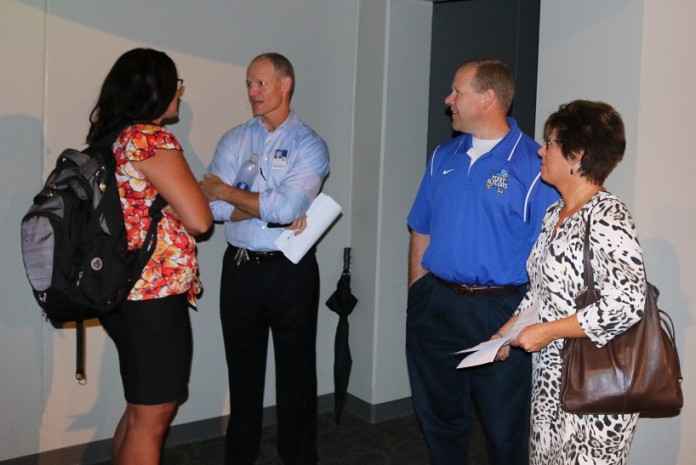
A team of three central Iowa mental health professionals led a series of mini-seminars Tuesday morning for teachers in the Perry Community School District. The training aimed at equipping teachers to prevent student suicides by recognizing warning signs of distress.
The school-sponsored seminars follow by six months the “Speak Out” suicide prevention and awareness presentation at the McCreary Community Building, organized by concerned local parents and sponsored by Perry’s First Christian Church E.D.G.E. Children Ministries.
Tuesday’s meetings at Perry High School were part of the district’s professional development of its 140 full-time and four part-time teacher faculty. The three-hour event began in the Perry Performing Arts Center, where the full faculty gathered to hear Superintendent Lynn Ubben introduce the mental health professionals.
“We’re pleased to bring these mental health experts to Perry this morning,” Ubben said, “as part of our ongoing efforts to help you develop resources and competencies in managing this important and troubling issue.”

Ubben introduced Dena Owens, a Drake-trained expert in school and community counseling. Owens is the director of Providence Place in Grimes, a private practice offering school-based therapy and support services.
Owens has extensive training and experience in trauma-related conditions and in dual-diagnosis and multi-occurring conditions. She described for the Perry teachers conditions such as ADD, ODD, depression, anxiety and other common mental illnesses of children and adolescents.

Perry High School Counselor Tami Valine said Owens has provided in-school, one-on-one therapy sessions with Perry students. This form of house-call therapy saves students and their parents the cost of driving to Owens’ office in Grimes, Valine said.

Joining Owens was Jennifer Ulie-Wells, assistant professor of education at Grandview University and an active member of the National Alliance on Mental Illness (NAMI).
Ulie-Wells geared her presentation to professional development tips for pre-kindergarten through 12th grade teachers, covering mental health topics ranging from trauma-informed care to classroom strategies and gate keeping, a method of spotting warning signs in suicidal students.

Dr. Jeffrey Kerber rounded out the team of presenters Tuesday. Kerber is the clinical administrator and program administrator for the student assistance program (SAO) at UnityPoint Health in West Des Moines.
Kerber, who services UnityPoint’s contract with the Des Moines Public Schools, said the purpose of Tuesday’s presentations was “to reach out and improve the nature of the schools and focus on awareness and readiness to deal with student suicide.”

PHS Counselor Ann Horgen said the mini-seminars helped “raise awareness” among Perry teachers, who showed a “very positive response to the presentations.” She described the presentations as “useful” and “helpful” and said the district plans to follow up with additional mental health professional development in the coming months.

With an annual suicide rate of 7.2 per 100,000 people, Dallas County is about average for Iowa counties. Dallas County Public Health Director Shelley Horak said suicide statistics for Dallas County are not always easy to find or up to date.
The data is collected by the state, Horak said, and the freshest numbers are often several years old, “so there are several ways you can represent suicide in Dallas County, but you will always be stuck with this older data that’s behind.” Suicide is also bound up in a complex set of closely related behaviors, she said.
“There’s not a specific set of funding to prevent suicides,” Horak said. “We kind of address suicide along with all risk behaviors, especially with youth but with anyone who’s prone to having a clinical mental health diagnosis or someone who happens to be impulsive, maybe has a co-morbid substance abuse issue. Those people are all at higher risk. And when I say substance abuse, I would also include pathological gamblers. Older people are also at higher risk.”
Online resources for readers wanting to learn more about suicide prevention in Iowa include the Iowa Department of Public Health and the American Foundation for Suicide Prevention.
If you are feeling suicidal or are concerned about someone else, visit the Suicide Prevention Lifeline or call at 800-273-TALK.

















As a mother of a son that completed taking his life, I have spent hours trying to inform others and raise awareness of the signs and symptoms that often appear before someone takes their own life. As a survivor of a suicide attempt, I would try to impress that sometimes it feels like the only way to end the pain one is feeling. At my lowest point, I couldn’t see that tomorrow is a new day. Keep up the good work!! Suicide is highest in young men between the ages of 10-24 and is on the rise. Prevention only comes with education. We need more of this in our schools.